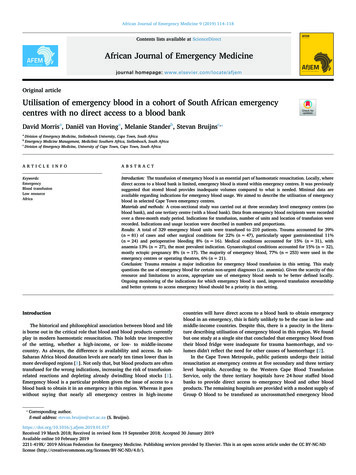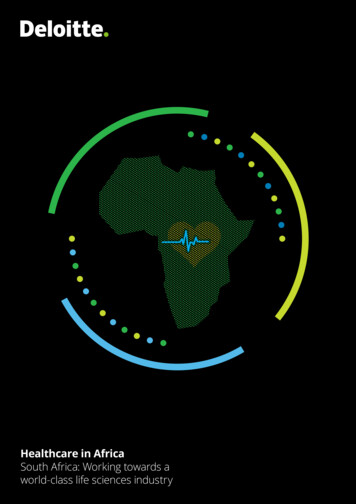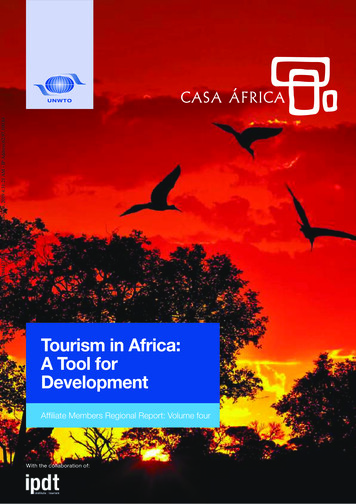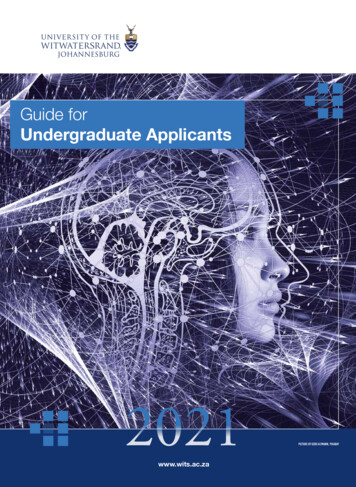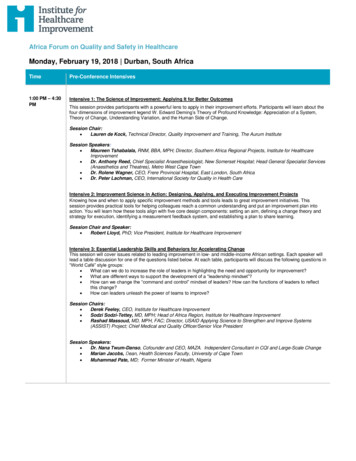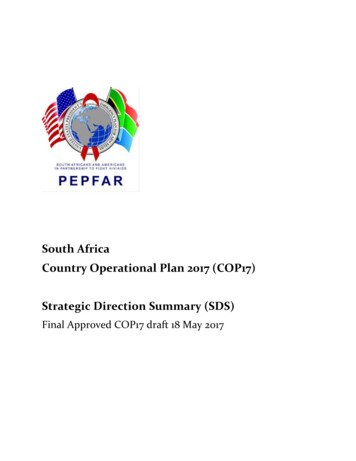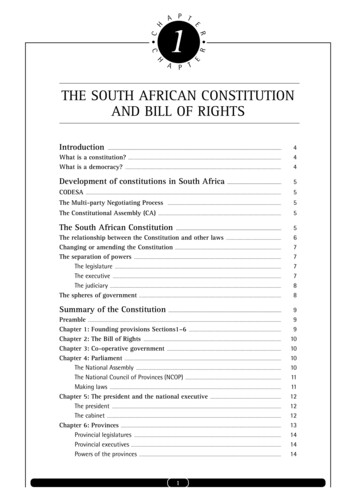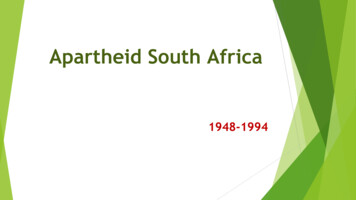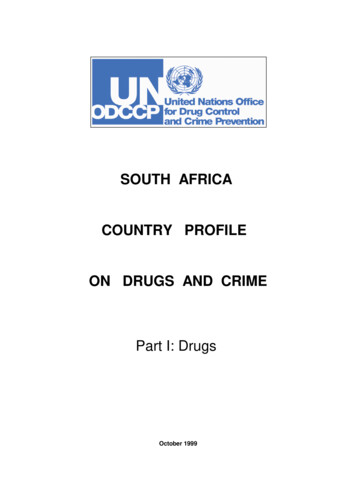
Transcription
SOUTH AFRICACOUNTRY PROFILEON DRUGS AND CRIMEPart I: DrugsOctober 1999
CONTENTS1. Background and Overview of the Drug Situation . . . . . . . . . . . . . . . . . . . . . . . . .12. Summary Statistics . . . . . . . . . . . . . . . . . . . . . . . . . . . . . . . . . . . . . . . . . . . . . . . . .33. General Setting3.1 Major characteristics of the country: socio-economic backgroundrelevant to the drug problem . . . . . . . . . . . . . . . . . . . . . . . . . . . . . . . . . . . .44. Drug Situation4.1 Cultivation and production . . . . . . . . . . . . . . . . . . . . . . . . . . . . . . . . . . . . . .4.2 Manufacture . . . . . . . . . . . . . . . . . . . . . . . . . . . . . . . . . . . . . . . . . . . . . . . .4.3 Diversion of precursors . . . . . . . . . . . . . . . . . . . . . . . . . . . . . . . . . . . . . . . .4.4 Trafficking . . . . . . . . . . . . . . . . . . . . . . . . . . . . . . . . . . . . . . . . . . . . . . . . .4.5 Diversion . . . . . . . . . . . . . . . . . . . . . . . . . . . . . . . . . . . . . . . . . . . . . . . . . . .4.6 Drug Prices . . . . . . . . . . . . . . . . . . . . . . . . . . . . . . . . . . . . . . . . . . . . . . . . .4.7 Demand . . . . . . . . . . . . . . . . . . . . . . . . . . . . . . . . . . . . . . . . . . . . . . . . . . .4.8 Consequences (HIV/AIDS) . . . . . . . . . . . . . . . . . . . . . . . . . . . . . . . . . . . . .4.8 Consequences (HIV/AIDS) . . . . . . . . . . . . . . . . . . . . . . . . . . . . . . . . . . . . .1013131524242626295. Policy5.1. Drugs . . . . . . . . . . . . . . . . . . . . . . . . . . . . . . . . . . . . . . . . . . . . . . . . . . . . .5.1.1 National drug control framework . . . . . . . . . . . . . . . . . . . . . . . . .5.1.1.1.National Drug Control Budget . . . . . . . . . . . . . . . . . . . .5.1.1.2.Conventions adherence . . . . . . . . . . . . . . . . . . . . . . . . .5.1.1.3 Legislation . . . . . . . . . . . . . . . . . . . . . . . . . . . . . . . . . . .5.1.1.4 Drug control institutions . . . . . . . . . . . . . . . . . . . . . . . . .5.1.1.5 Main characteristics of national drug control policy . . . .5.1.1.6 Control of licit drugs . . . . . . . . . . . . . . . . . . . . . . . . . . .5.1.2 Supply reduction . . . . . . . . . . . . . . . . . . . . . . . . . . . . . . . . . . . . .5.1.3 Demand reduction . . . . . . . . . . . . . . . . . . . . . . . . . . . . . . . . . . . .5.1.3.1 Prevention . . . . . . . . . . . . . . . . . . . . . . . . . . . . . . . . . . .5.1.3.2 Treatment . . . . . . . . . . . . . . . . . . . . . . . . . . . . . . . . . . .5.1.4 Money laundering control measures . . . . . . . . . . . . . . . . . . . . . . .5.1.5 International/ regional co-operation . . . . . . . . . . . . . . . . . . . . . . .5.2. Co-operation with international bodies . . . . . . . . . . . . . . . . . . . . . . . . . . . .3030303030313131313232323232336. Overview of International Assistance . . . . . . . . . . . . . . . . . . . . . . . . . . . . . . . . . .6.1. UNDCP programme of assistance . . . . . . . . . . . . . . . . . . . . . . . . . . . . . . .6.2. Other donors' programmes of assistance . . . . . . . . . . . . . . . . . . . . . . . . . .3333357. Annex (UNDCP’s planned future activities) . . . . . . . . . . . . . . . . . . . . . . . . . . . . . .368. References . . . . . . . . . . . . . . . . . . . . . . . . . . . . . . . . . . . . . . . . . . . . . . . . . . . . . . . .37
-11.BACKGROUND AND OVERVIEW OF THE DRUG SITUATIONSouth Africa’s geographical location and its international trade links with countries in Asia, Latin America,Western Europe and North America have made it an attractive drug transit country. Drug trafficking andabuse have escalated in recent years, particularly in the years prior to and shortly after the installationof a democratically elected government in 1994 which ended the country’s socio-economic and politicalisolation. The relaxation of strict control of land, air and sea borders along with the enhancement ofinternational trade and commerce have triggered the increase in drug trafficking. South Africa has anexcellent infrastructure of roads and rail, telecommunication, airports, and seaports facilities. All of theseare also used to transit illicit drugs, particularly cocaine, heroin and methaqualone.Since the early 1990s, South Africa has seen a slow but steady increase in the availability and use ofillicit drugs such as cannabis, cocaine, heroin, LSD, amphetamines, and Ecstasy (Atkins 1997, Parry,Bhana & Bayley, 1998). Various factors have contributed to the increase in abuse, including an increasein legal and illegal migration, reductions in internal and border controls following the collapse of theapartheid regime, social and political liberation which also facilitated the arrival of new youthsmovements such as the ‘rave culture’. In addition, more effective policing of traditional smuggling routesprompted the drug cartels in Asia and South America to look for other shipping routes. In the process,a proportion of the drugs trafficked ended up on the local market. Other factors include highunemployment, weakened family and social structures - a result of many years of apartheid policies and the establishment of clandestine laboratories manufacturing drugs such as methaqualone. Moreover,the relative affluence of South Africa in the region makes it an attractive ‘emerging market’in its ownright (Kibble, 1998; Parry, 1997; Simon 1998).Moreover, there has been a "tradition" of drug consumption in the country. The use of cannabis, knownas dagga in South Africa, dates back to the 15h century. Arab as well as Persian and Indian merchantswere inter alia responsible for its spread along the eastern coast of the African continent (13th century).As of the 15th century Suaheli merchants in eastern Africa and some bantu tribes in central and southernAfrica co-operated in brought the plant to southern Africa where it was later also cultivated. Cannabisgained in popularity in the 18th and 19th century (OGD, 1996). In 1928 authorities in South Africaintroduced the first drug legislation concerning cannabis (Wright, 1991). The use of cannabis was for along time largely limited to the African population. Only over the last few decades, cannabis also gainedpopularity among the coloured and the white population.After world war II methaqualone, a depressant, also known as mandrax, emerged as another importantpsychoactive substance. Following the identification of its abuse potential, methaqualone was removedfrom the legal market and classified as a prohibited dependence-producing drug in part I of the scheduleof the South African narcotics law (Act 41 of 1971). However, since official withdrawal from the localmarket, methaqualone tablets were diverted from international distribution channels - mostly originatingin India -, and were later also illicitly manufactured in neighbouring African countries as well as in SouthAfrica itself. Abuse was originally strong among South Africa's ethnically Indian population before itspread to other ethnic groups, including the country’s African population.Mandrax is today the second most widely abused substance in South Africa after cannabis. It started tobecome a general problem for South African society as of the late 1980s. Allegations have been madethat among the groups fighting the apartheid regime1 some may have been involved in the traffickingof mandrax in the late 1980s and early 1990s to finance weapon purchases (OGD 1996) Some otherindividuals/groups - apparently with support from the apartheid regime - started manufacturing varioussynthetic drugs (including methaqualone and ecstasy) for potential use in anti-apartheid demonstrationsand, more generally, to “appease”the population that was fighting for its rights. While the first allegationhas remained at a level of general accusations, the second - manufacture of synthetic drugs on behalfof the apartheid regime - has led to a court case. There have been some indications from the Truth andReconciliation hearings that a “cozy relationship”may have existed between the apartheid governmentand certain criminal groups, and that the apartheid government may have acquiesced in, if notencouraged, the trafficking in narcotics to some ethnic groups as a means of social and political control(INCSR 1999).1Allegations concerned some groups linked to the Pan African Congress who allegedly imported mandrax via Mozambique intoSouth Africa (OGD 1996).
-2In addition, LSD, mostly imported from Europe, has emerged as a drug of choice among some pocketsof mostly young and white South Africans over the last few decades. By contrast, until a decade ago,abuse of cocaine and heroin was hardly known as a major problem in South Africa. The same appliedto amphetamines, and ecstasy. This started to change, however, in the 1980s and became morepronounced in the 1990s. While ecstasy and amphetamines are mainly imported from Europe - to satisfydomestic demand in the club scene (mostly frequented by young whites), South Africa has also becomepart of major internationally operating drug networks (often organized by Nigerians) linking the drugproducing countries of Latin America (cocaine) and Asia (heroin) with the "traditional" cocaine andheroin markets of Western Europe and North America (Interpol, 1997). As South Africa has an excellentinfrastructure in terms of roads, rail, telecommunication, airports, and seaports, etc., and faces resourceshortages in the area of drug control, criminal groups exploit this situation.Like other countries located on major drug trafficking routes, South Africa started to fall victim to a drugepidemic of crack-cocaine (less so of heroin). The relative affluence of South Africa in the regionmakes it an attractive ‘emerging market’in its own right. (Kibble, 1998; Parry, 1997; Simon, 1998). Theepidemic may not be - as yet - dramatic by North American standards, but it has the potential toendanger the post apartheid transformation process of society and can disrupt the fragile set-up of SouthAfrican society which is already characterized by high rates of crime, violence and a spread of fire-arms.There are no signs that the current epidemic is coming to an end soon. In some parts of South Africa,crack-cocaine appears to have taken the second place after cannabis. More than in other countries, drugtrafficking activities of organized crime groups are linked to a multitude of other criminal acts, rangingfrom car thefts and robberies to smuggling in arms, in stolen cars, in rhino horn, ivory, gems, etc.
-32.SUMMARY STATISTICSCultivation (hectares in 1997) Opium:Coca leaf:Cannabis:001,300*Production (in tonnes in 1997) Opium: Coca leaf: Cannabis:002,756** high margin of error.Potential manufacture (in kg) HeroinCocaineMethaqualone:nonenone; except for crack-cocaine out of cocainesignificantSource: UNDCP, Annual Reports Questionnaire Data.Seizures – comparison 1992-1994 averages and 1998Cocaine (base and salts)HeroinMethaqualone (reported in weight terms)Methaqualone (incl. units)***Cannabis resinCannabis herbCannabis plant* 1992-93** 1995*** transformed at 250 mg per unit.Source: UNDCP, Annual Reports Questionnaire Data.Average1992-1994 e1,095%236%433%-42%42%-57%-81%Seizures – international comparison – 1996-1998 averagesSouth Africa:seizures in absolute figures(1996-98 averages)kgCannabis plantCannabis herbMethaqualone(incl. units)Cocaine:Heroin:Cannabis resin365,739.2190,799.9362.4298.02.67.9as a percentage .3%0.1%0.0%0.0%AfricaWorld5.1%0.7%4.1%0.8%Source: UNDCP, Annual Reports Questionnaire Data.Memo:PopulationLand areamillionin 199738.8km²1,219,080Sources: UNDP, Human Development Report 1999, Weltalmanach ’99.
-43. GENERAL SETTING3.1. Major characteristics of the country: socio-economic issues relevant to the drug / crimeproblemSouth Africa combines in many respects the characteristics of a highly industrialized country with thoseof a developing country in Sub-Saharan Africa. The following description will highlight some of thesecharacteristics which should help to understand the special vulnerability of the country to drug abuse,drug trafficking and crime in general.GeographySouth Africa's territory extends to 1,219,080 km2 . It is thus about one eights of the size of the USA(9,809,155 km2), more than twice as large as France (543,965 km2), three times bigger than Germany(357,021 km2), some four times larger than Italy (301,302 km2) and five times larger than the UK(242,000 km2). (Weltalmanach ’99).While the political, economic and geographical isolation from the main drug production and consumptionareas prevented South Africa from emerging as a major drug transit country over the last few decades,this changed in the 1990s with the re-integration of South-Africa into the international community. Amodern communication and transport infrastructure, growing commercial links as well as porousborders, including with countries which were fighting civil wars (e.g. Mozambique) contributed to theincreased attractiveness of South Africa for drug trafficking purposes in the 1990s.PopulationAccording to UNDP data, South Africa's population amounted to 38.8 million in 1997, respectively to 40.6million according to revised 1996 census figures (released in October 1998). South Africa is thus thefourth most populated country in Africa after Nigeria (104 million), Egypt (65 million) and Ethiopia (58million). The size of South Africa's population is comparable to that of Spain (39.6 million). It is half aslarge as that of Germany (82.1 million) and about a third smaller than that of the UK (58.5 million),France (58.5 million) or Italy (57.4 million). (UNDP, 1999).The 1996 survey showed that 76.7% of the population were black Africans (Zulu, Xhosa, North- andSouth Sotho, Tswana, Tsonga, Swasi, Ndebele, Venda, etc.), 10.9% were whites (mostly of Dutch andBritish descent), 8.9% where coloured, and most of the rest (2.6%) were Asians (largely from the Indiansub-continent). Official languages are: Afrikaans, English, IsiNdebele, Northern Sotho (Sepedi),Sesotho, Swazi, Xitsonga, Setswana, Tshivenda, IsiXhosa and IsiZulu (EIU 1999-00).As drug consumption patterns in South Africa follow ethnic lines, a further break-down may be useful.Black South-Africans are the majority in the country except for Western Cape (region around CapeTown: 21% of the population) and Northern Cape (33%). There is a concentration of white SouthAfricans in Gauteng (region around Johannesburg: 23% of population) and in the Western Cape (21%of total population). Coloured South Africans are concentrated in Western Cape (54% of the population)and in Northern Cape (52% of the population). Asians are concentrated in KwaZulu-Natal (9%).Close to 50% of the population live in urban conglomerations, compared to 32% in Sub-Saharan Africaand 38% in developing countries. This share is forecast to grow to 56% by 2015. (UNDP, 1999).Urbanization is usually positively correlated with drug abuse.Population growth over the 1975-97 period was 2.1% p.a, significantly more than the growth rate amongindustrialized countries (0.6% p.a.) and about the same as the developing countries' average (2.0% p.a.).(UNDP, 1999) The strong population growth led to an overall very young population which tends to bevulnerable to drug abuse.But population growth rates are showing downwards. Population growth over the 1990-96 period fell to1.7% p.a., and a further downward trend is to be expected, largely a result of the wide spread ofHIV/AIDS in the country. One in five babies born in South Africa is already HIV positive (UNDCP-FO4/99). The average age of a South African born today is set to fall from currently 65 years to 56 years.(UNDCP-FO 11/98). UNDP projects population growth to fall to 0.6% over the 1997-2015 period. Thisis below the projection for developing countries in general (1.4%) (UNDP 1999).
-5ReligionReligion plays an important role in the life of ordinary South Africans - a fact which should be taken intoaccount in launching drug abuse prevention campaigns. Churches could be a potential partner in suchcampaigns. 78% of the people are Christians (1990), mostly Protestants. Most South Africans belongto one of the following Christian churches (in order of importance): various Independent Africanchurches, the Dutch-reformed church, the Catholic church, Methodists, Anglicans, Lutherans,Presbyterians, Congregational Churches, Baptists etc.1.2% were Muslims (1990), but this share may have increased in recent years. Some radical Muslimgroups in Cape-Town have already taken up the fight against drug trafficking and abuse, however, in avery violent form. The activities of these groups have, on several occasions, clearly exceeded legallimits (including murder), and proved thus to be more a reason for public concern than a symbol of civilsociety's support for a drug-free community.Gross domestic productSouth Africa's GNP amounted to 130.2 bn in 1997. It was thus equivalent to 44% of the total Subsaharan GNP in that year which underlines the economic importance of that country in Africa. GNP percapita was 3,210 in 1997, by far the highest such figure in Africa, four times more than in Zimbabwe( 720) and nine times more than in Kenya ( 340).Though higher than in the countries of Eastern Europe ( 2,249 per capita, including C.I.S), GNP percapita figures are still low if compared to the industrialized countries. GNP per capita figures in WesternEurope (Germany: 28,280; France: 26,300; UK 20,870; Italy 20,170) and North America (USA 29,080; Canada: 19,640) are six to nine times larger than in South Africa.2The total GDP of South-Africa of 139.1 bn (1997) is smaller than that of a country such as Austria ( 206bn) (UNDP, 1999). All of this explains that South Africa - though emerging as a drug market - is, for thetime being, still more of a drug transit country.Income distributionSouth Africa - more than other countries - is characterized by a strong inequality in income distribution,which goes along racial lines. The 20% richest of the population earn 19 times more than the 20%poorest. For comparison, in the United States the rich - as defined above - earn 9 times more than thepoor; in Germany, Italy, France or Spain they earn 6 to 7 times more and in more egalitarian societies,such as Sweden, the Netherlands or Belgium, the multiplier is at less than 5. Even if compared todeveloping countries in Sub-Saharan Africa, the existing income gaps in South Africa are large. Themultiplier is 15 in Zimbabwe, 13 in Zambia and Mauritania, 9 in Nigeria, and 6 to 7 in Côte d'Ivoire,Nigeria, Tanzania and Uganda.Per capita income of the 20% poorest of the population in South Africa, calculated at purchasing powerparity, was 516. This is still twice as high as in Zambia ( 216) or in Kenya ( 238) and two thirds higherthan in Nigeria ( 308). But data also show that South Africa's poor earn less than a tenth of the poor inthe USA ( 5,800 per capita) (UNDP, 1999).All of this has a number of implications: (i) higher levels of income in South Africa for the underprivileged than in other African countries make South Africa attractive as a location for immigration which- as experience has shown - tends to create a favorable climate for drug trafficking activities; (ii) at thesame time, strong income inequalities raise the readiness of underprivileged groups to participate inillegal activities, including drug trafficking; (iii) the rather high levels of income of the "rich" make thecountry also interesting for drug imports from abroad.2If GDP per capita figures are calculated on a PPP (purchasing power parity) basis, South Africa's figure amounted to 7,190 in1997. GDP per capita in western Europe and North America was then three to four times larger than in South Africa. However, forglobally operating drug cartels, theoretical PPP calculations are not really of importance.
-6Official development assistanceFollowing the abolishment of the apartheid regime, South Africa became a recipient of developmentassistance (ODA). In 1997 ODA amounted to some 500 million, equivalent to 0.4% of GNP. This washalf the share received by developing countries in general (0.9% of GNP), and only a small fraction ofwhat was received by Sub-Saharan countries in general (6.7% of GNP). Smaller ODA reflected thestrength of the economy as compared to other developing countries.Economic growthPolitical and economic isolation of the country under the previous apartheid regime in combination witha strong population growth resulted in an actual decline of GDP per capita over the 1975-97 period by-0.6% p.a. The deterioration in Sub-Saharan Africa was even worse (-1.3% p.a. over the same period).Nonetheless, results in South Africa were far worse than in the industrialized countries where per capitaGDP grew by 2.2% p.a., or in the developing countries where it grew by 2.1% p.a. over the 1975-97period. (UNDP, 1999).Following negative growth rates in the early 1990s, the election of a democratic government in 1994 ledto an acceleration of GDP growth to 2.7% p.a. over the 1994-98 period. However, growth lost againmomentum in recent years. By 1998 GDP growth had fallen to 0.5% on a year earlier. A number offactors have been responsible for this deceleration. They include high levels of crime and violence,perceived as being out of control among broad sections of the population (even though they seem tohave fallen in the most recent years). The of lack of internal security did not contribute to an environmentthat would have been conducive for undertaking long-term investment. Investors continue to cite crimeas the biggest deterrent to conducting business in South Africa (EIU 1999-00).Direct foreign investment flowing into South Africa fell from US- 1.7 bn in 1997 to US- 0.4 bn in 1998.On the other hand, direct foreign investment of South African companies abroad rose from levels ofbetween 0.1 bn and 0.3 bn p.a. over the 1994-96 period to 1.4 bn in 1998. (IMF, 1999) This meansthat more is invested by South African companies abroad than by foreign companies in South Africa.Overall gross domestic investment in South Africa was equivalent to 17% of GDP in 1997. This was inline with the average of Sub-Saharan Africa (18%) but lower than the industrialized countries' average( 21%) and significantly lower than the developing countries' average (27%). (UNDP 1999).Economic growth in South-AfricaGrowth of GDP on a year earlier in 9972.73.43.21.719980.5IMF, International Financial Statistics Yearbook 1998; The Economist Intelligence Unit, South Africa Country Profile1999-00 and 2nd Quarter 1999 South Africa Country Report.UnemploymentEconomic growth was not sufficient to lower unemployment. The number of registered unemployed rosefrom 271,000 in 1994 to 310,000 in 1997 (IMF, 1999) and 356,000 in 1998 (preliminary figure accordingto EIU), i.e. by almost a third over the 1994-98 period. More significant are the large number ofunemployed who are not even registered. The total number of people unemployed (including those notregistered) has been estimated at 4.6 million people in 1997. With just 7.6 million people formallyemployed, the unemployment rate amounts to a staggering rate of close to 38% (1997). Onceemployment in the informal sector is included (total employment of 15.1 million people), theunemployment rate in South Africa would amount to 23% which is still extremely high by internationalstandards (EIU, 1999). For comparison, the 1997 unemployment rate in Italy was 12.5%; in France12.4%; in Germany 9.8%; in the UK 7.1%; in the Netherlands 5.6%; in Austria 5.2%; and in the USA5.0%.
-7It goes without saying that such high rates of unemployment make South Africa highly vulnerable to drugtrafficking and drug abuse. Studies in other countries have shown that risks of drug taking andinvolvement in drug trafficking activities are far higher among unemployed than among those employed.Unemployment in South Africa1994199519961997Unemployment (in thousands)3,6723,3214,1974,551Workforce in the formal sector (in thousand)7,9718,0697,5907,548Workforce in the formal and the informal sectors (inthousand)14,18714,50114,91115,149Unemployment rate(No. of unemployed as a percentage of formalworkforce & unemployed)31.5%29.2%35.6%37.6%Adjusted unemployment rate (No. of unemployed as apercentage of formal and informal workforce &unemployed)20.6%18.6%22.0%23.1%Source: Economist Intelligence Unit, South Africa Country Profile 1999-00.CrimeSouth Africa has been affected by a high levels of violence and crime in recent years which gained inseriousness in the last years of the apartheid regime and continued to remain at very high levelsthereafter. The overall number of crimes committed rose slightly from 2 million in 1994 to 2.2 million in1998. The overall perception in South Africa, however, is one of a rapidly deteriorating situation. In 1994South Africa had 462 prisoners per 100,000 people, more than the United States (208) and more thanin European countries (Netherlands 182, Italy 177, Sweden 162, Spain 157, France 138 etc.). (UNDP,1999).Foreign TradeSouth Africa's foreign expanded strongly since the end of the apartheid regime. The increases may notseem very large in dollar terms, but they are large once based on the local currency. Exports grew - interms of Rands - by 62% over the 1994-98 period and imports rose by even 88% over the same period.It should not surprise that such increases in legitimate trade are also exploited by drug traffickingorganisations as they smuggle illicit substances along with legitimate merchandise. Exports of goodsand services in South Africa were already equivalent to 28% of GDP in 1997, which is already a highershare than for countries such as Germany (24%), France (24%), Australia (20%) or the USA (12%).South Africa runs a trade surplus. But its current account balance turned negative after 1993 and it hasbeen deteriorating since.Foreign Trade and Current Account of South Africa19941995199619971998Exports (bn Rands) f.o.b.*89.9101.5126.1142.9145.5Imports (bn Rands), f.o.b.*76.298.0115.5129.7143.3Exports (in bn US- ) f.o.b*24.928.829.730.428.1Imports (in bn US- ) f.o.b*21.527.127.428.426.9Merchandise trade balance (in bn US- )3.41.72.32.01.2Current account balance (in bn US- )-0.3-2.8-1.7-1.9-2.3*f.o.b. free on boardSource: IMF, International Financial Statistics, August 1999.
-8Exchange rate, financial markets and inflationThe return of confidence after 1994 and advice given by the international financial institutions promptedthe Government to abolish the "financial rand" in March 1995. The second-tier currency, available onlyto foreigners, traded at a discount to the "commercial rand". The old system intended to allowconventional balance of payments transactions, while trying to insulate the country from politicallyinduced capital flight. However, the system also contributed to the development of sophisticated financialschemes to circumvent such rules - a knowledge which is also asked for in money launderingoperations.With the emergence of a democratically elected government and the unification of the exchange rates,the attractiveness of South Africa for commercial and financial transactions increased. Data of financialflows show that there has been a strong increase in both capital inflows and outflows over the last fewyears. Notably portfolio investment increased, exceeding direct foreign investment flows. Capital inflowsfor portfolio investment grew - according to IMF data - from 1.1 bn in 1993 to 13 bn in 1998; the netinflows reached a high of 8.3 billion in 1997 before falling back to 7.6 billion in 1998. All of these arelarge sums compared to flows to other developing countries. The net capital inflow for portfolioinvestment in 1997 was - according to UNDP data 3 - 11.8 bn in China, 5.1 bn in Brazil, 4 bn in India, 3 bn in Colombia, 1.5 bn in Thailand; 0.6 bn in Pakistan, 0.3 bn in Nigeria, 0.1 bn in Egypt andMorocco and less than 0.1 bn in all other African countries (UNDP, 1999).It thus has to be feared that parallel with the increased attractiveness of South Africa for legitimateinvestors, its attractiveness for money laundering operations may have risen as well though there hasnot been any evidence or indication (so far) of large-scale money laundering operations taking place inthe country. However, South Africa signed only in 1999 the 1988 Convention which foresees strictcontrols to detect and prevent money laundering operations.South Africa: Financial flows in billion US- 4.65.41.12.13.12.38.37.6Capital inflows0.00.31.00.81.70.3Capital ital inflows-2.10.34.22.1-1.2-1.2Capital ital inflows-1.02.78.36.013.412.1Capital olio investmentCapital inflowsCapital outflowsNet-inflowsDirect foreign investmentNet-inflowsOther investmentNet-inflowsOverall financial flowsNet inflows (incl. adjustments)Source: IMF, International Financial Statistics, August 1999.As the country showed to be a vulnerable to political and economic rumors - as reflected in strongfluctuations of the Rand (notably in 1998) - South Africa may not necessarily be an ideal location forlong-term investment by money launderers; money launderers tend to follow market movements andshift funds abroad, thus aggravating existing trends. The Rand fell from levels of around R3.6: 1 in1994/95 to R6.8: 1 by July 1998. A six percentage points rise in the prime lending rate (repo) to 24%in June-July 1998 helped to stabilise the Rand; but the measure brought economic growth almost to ahalt
-2-In addition, LSD, mostly imported from Europe, has emerged as a drug of choice among some pockets of mostly young and white South Africans over the last few decades. By contrast, until a decade ago, abuse of cocaine and heroin was hardly known as a major problem in South Africa. The same applied

